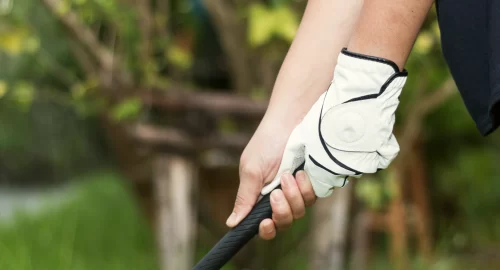
Now is the perfect time of year to play a new golf course; the conditions are perfect and you might have some more free time to enjoy! Whether you’re on vacation or want to mix things up at a new course near home, it’s always fun to test your game on a new golf course.
Find a friend or group of golf buddies to share the experience with before the winter weather ends your golf season. As Gary Player said, “In golf, as in life, it’s the friends we meet along the way that make the journey worthwhile.”
While it’s exciting, new terrain and an unfamiliar course can also be nerve wracking, especially as a beginner golfer. Today, we’ll help you learn how to play a new golf course with seven proven strategies in our golf for beginners guide!
How to Approach a New Golf Course
1. Research the Course
Once the tee time is booked, do some research ahead of time to see if you can learn more about the venue. Start by visiting the golf course website to view the scorecard and other details online.
A lot of courses will also have hole-by-hole flyovers and even online yardage books. This makes it easier to get an overview of each hole, learn how to play certain holes, and get more familiar with the layout.
If the golf course doesn’t have a ton of information on their website, check out YouTube or social media. It’s not uncommon for other players to do course vlogs on YouTube and share clips on social media as well.
Lastly, you can always download an app on your phone that provides hole overviews for thousands of courses. Doing some research ahead of time can help you show up prepared and hopefully minimize any golf nerves.
2. Arrive at Least an Hour Early
The second strategy to play a new golf course is to arrive earlier than normal. This way you can avoid any potential traffic delays and avoid stress before you try to enjoy your day on the course.
Any time you’re trying out a new course, it’s a good idea to arrive 60 minutes (or more) before your tee time to warm up and get loose. This gives you plenty of time to check in at the pro shop, grab a drink, warm up, and explore the practice facilities.
Start by hitting plenty of putts to test out the speed of the greens. Next, hit a few chips/pitches to see how the greens react for your short game. Then head over to the driving range to loosen up, stretch, and get ready for the day.
Before teeing off, it’s also a good idea to ask the starter if there is any local knowledge you should be aware of. They might have some extra course knowledge that can help you better understand the course as a new player. Write down any notes on your scorecard so you can remember these pieces of advice throughout the round.
3. Play the Right Tee Box (Tee It Forward)
As you speak with the golf course staff, it’s a good idea to ask what tee boxes you should play too. You can always check the course rating and slope, but sometimes it’s good to ask a local as well.
This ensures you’ll play the right tee box and have the most fun during the day. Playing a set of tees that match your skill level will avoid both pace of play issues and unnecessary frustration.
Don’t be afraid to play a tee box up than normal if you’ve never played the course, either—especially if the course has a lot of penalty areas, fast greens, or thick rough. Playing up a box will help build confidence and get a good first impression of the course.
Also, make sure to check out this article on other common beginner golf mistakes.
4. Use a GPS, Watch or Rangefinder

While some golf carts have GPS devices to provide details of the course, many don’t. Make sure you’re prepared and have a rangefinder, golf GPS handheld device, or golf watch so you can learn more about each hole.
If you have a GPS or golf watch, make sure the new course is downloaded the day before in case the internet at the course isn’t reliable. This way you can get an overview of each hole and learn the distances to different hazards.
One of these devices will make it much easier to have a strategy for every hole so you can walk on the tee box with confidence. If your tee shots need help and you’re tired of slicing it, don’t forget to check out the SF1 Driver. This one-of-a-kind anti-slice driver is making golf easier for amateurs by improving your driving distance and accuracy.
5. Change Your Course Strategy
If you’re playing a new golf course, you might want to consider a more conservative course strategy. Focus on hitting fairways and greens so you can avoid blowup holes and hopefully enjoy yourself more during the round.
Stick to your strengths and don’t try to hit shots you can’t pull off in practice. This will help you avoid penalty areas and hopefully shoot lower scores.
6. Take Notes for Next Time
As you go through the round, make sure to take notes for the next time you play the golf course. Log notes in your phone for easy access, or write them down on your scorecard.
Write down things like:
- Any trouble you might not be able to see off the tee.
- Tricky pin positions that may not be worth trying to hit toward.
- What clubs to use on certain shots (especially par 3s, as they tend to have the highest scoring average compared to par 4s and par 5s).
7. Enjoy the Experience
While these tips will help you learn how to play a new golf course, don’t forget the most important rule – have fun! The right mental attitude during a new round is key to playing your best and ensuring you have a good time.
The more fun you have, the better you will likely play too.
You’re Ready for Your Next Adventure
To show up ready for a new course, don’t forget to dial in your practice routine leading up to your tee time. Focus on the basics like setup, alignment, takeaway, and good tempo.
If you need help in practice and can’t figure out your swing, check out Swing Fix AI. This amazing software lets you upload a video of your swing and get instant feedback. We’ll provide you with tons of drills and tips so you can improve your game fast!

